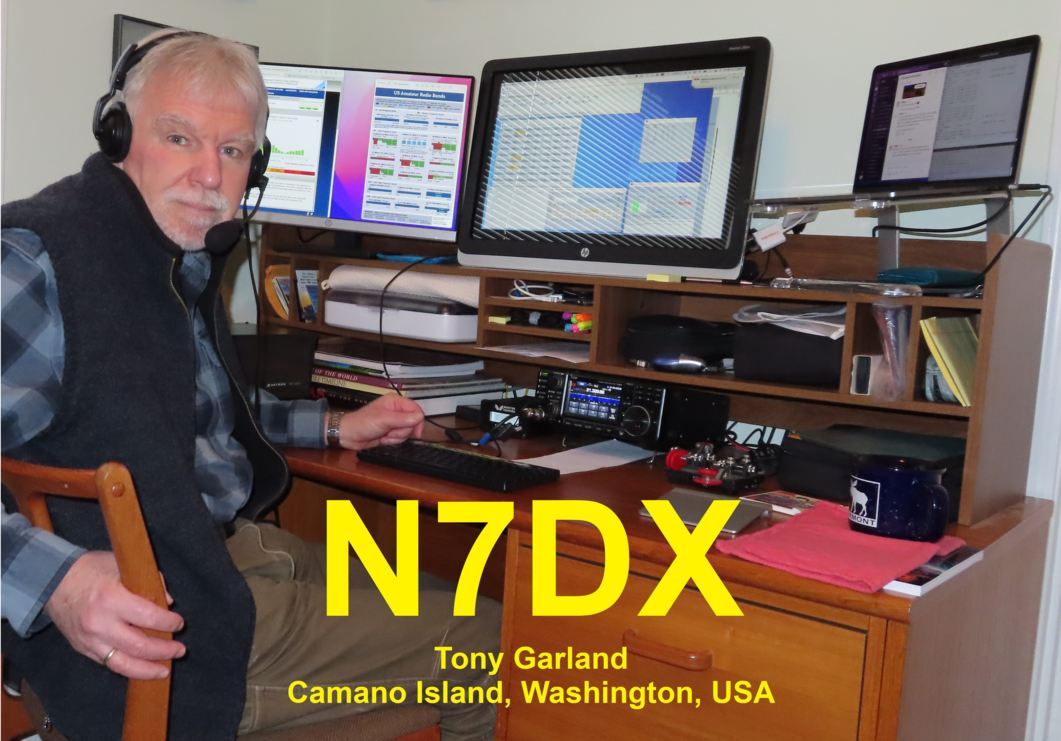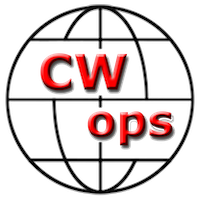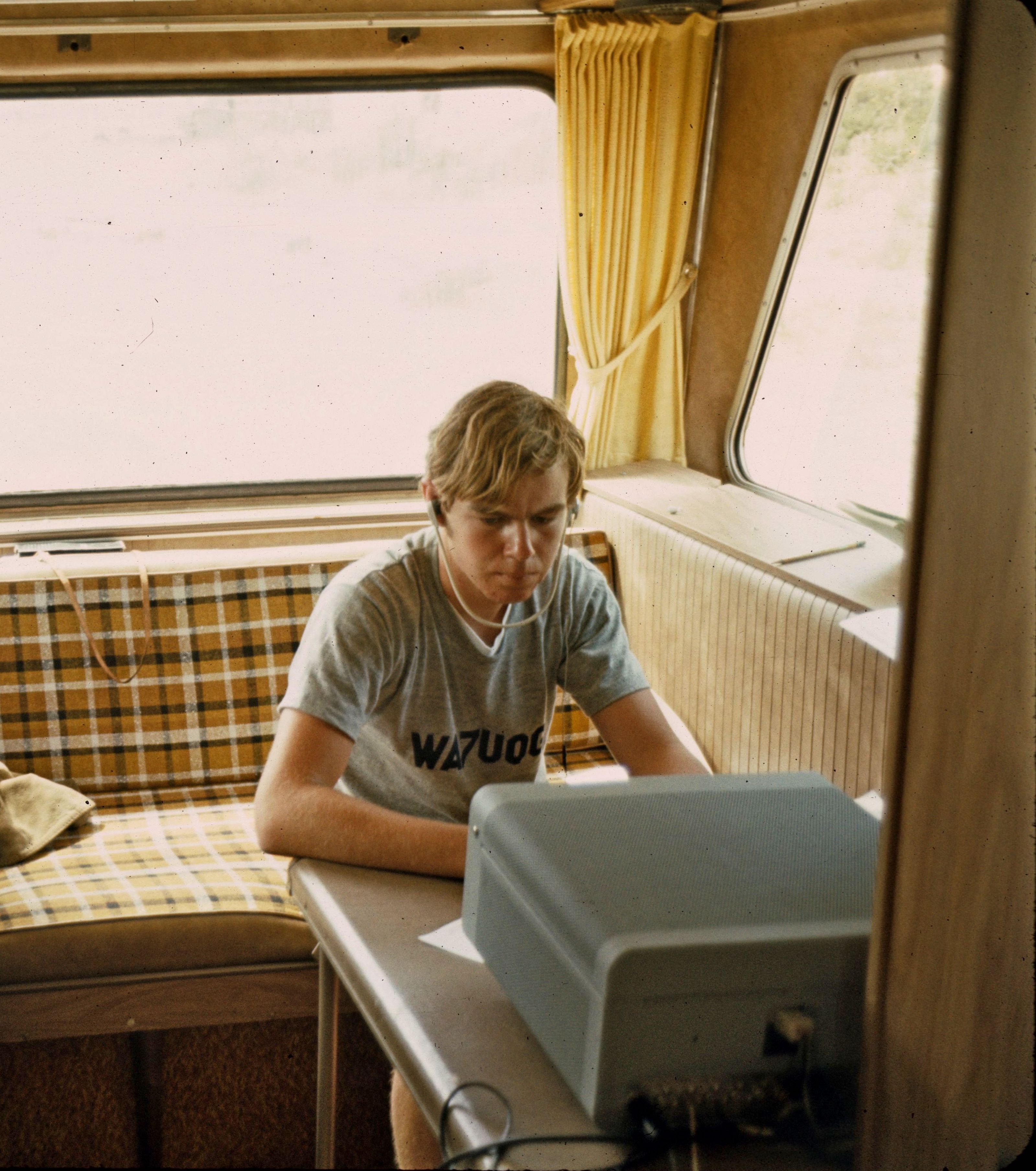
| CONTACT |  |
| QTH | 1373 Bonanza Alley Camano Island (Island County) Washington, 98282-8431 USA |
| QSL | LOTW, QRZ.com, (eQsl.cc on-request) PLEASE... |
| REMOTE | N7DX@K7RL, N7DX@K7RI |
| CONTESTS | 3830scores.com |
| MEMBER | Western Washington DX Club CWops.org #2764  |
| FAITH | Christian |
A minimalist station on HF: an ICOM-7300 driving 100 watts into a 27-foot "all-band" roof-mounted vertical with 15 radials.
The vertical is a stripped-down Butternut HF6-V with all the coils and stubs removed and a jumper across the upper insulated section to form a single continuous conductor.[1]
The vertical and 15 radials are non-resonant: the base of the vertical is tuned using an SG-230 "Smartuner" (remote automatic antenna tuner).[2] This results in a visually cleaner installation with greater flexibility than the original Butternut, allowing operation on all portions of all bands from 160 through 10 meters. Ongoing maintenance should be reduced as we live in a high-wind area directly east of the Strait of Juan-de-Fuca.
Although the SG-230 tuner is weather-proof, I decided to give it additional protection from long-term UV-exposure by mounting it inside a commercial Rubbermaid tub. The tub is then attached to south (sun) side of the roof-mount antenna tripod. Since the tripod sides are sloping, this also gives the tuner additional rain protection.
One could argue mounting the antenna on the upper roof would provide better results, but I decided to mount the antenna on the lower roof for several reasons: 1) the upper roof is more dangerous to work on; 2) the lower roof offers more room for longer radials; 3) the antenna is less noticeable on the lower roof.
The antenna is guyed at the 20 foot level using 1/8" black dacron rope--hardly visible at-a-glance.
My initial interest in electronics was sparked one Christmas when I received a "50-in-1" kit from Radio Shack. Thereafter, a buddy of mine (now KB7RYY) and I became interested in listening to shortwave radio (SWLing). I saved up my money, purchased and built a Heathkit GR-64 shortwave receiver. It wasn't long after that when I began listening to interesting transmissions from local amateur radio operators. Soon, we were studying for our ham licenses.
I obtained my first license at age 16, back in 1972. My original call was WA7UQG. As a teen, I operated from my parent's house in Normandy Park, south of Seattle. My first transceiver was a Heathkit HW-16 (CW only). Later, I graduated to a Heathkit HW-101 (CW + SSB) transceiver.
One of my Elmers was the well-known DXer Bill Bennett (W7PHO) who lived just a few miles away. Bill introduced me to the Western Washington DX Club where I became interested in DX and contesting. Another Elmer who helped me study and pass my Extra-class license was Ken Barroll (now W7OP).
After high school, I attended college at the University of Washington where I set up a station in my dorm room running a Heathkit HW-101. One of my room mates was also a Ham, Walt Legowski (WA1KKM).
After graduating from college and getting married, I lived on a sailboat for a number of years--where I still have a portable station using an ICOM-735 and SG-230 remote antenna tuner feeding the back stay (about a 43 foot long sloping wire) against a copper counterpoise installed inside the hull of the boat.
Other than a few years as a net control for the Seafarer's Net (running telephone patches for boats transiting the Pacific), other interests and activities left less time for amateur radio. My operating activity dwindled for many years. When a remodel project intervened, my antennas had to come down and the radios were boxed up--where they remained for almost 20 years. Other than an occasional contact made from the boat, I was effectively off the air.
In 2017, some early ham friends, Tom Owens (K7RI) and Walt Legowski (WA1KKM), stopped by for a visit. Later, Tom invited me as a guest operator in multi-operator contests and the bug bit again. It took me a couple of more years before I set up the home station I have now.
